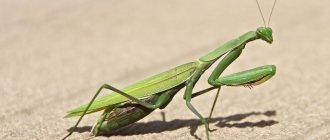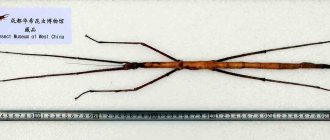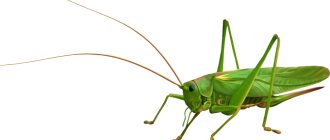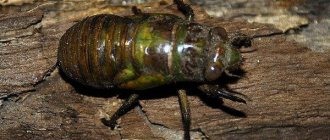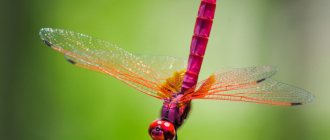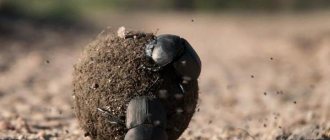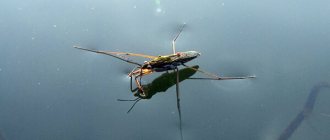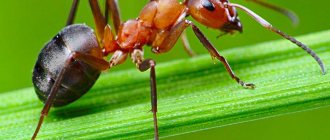- Wild animals
- >>
- Insects
A curious little insect, which, on the one hand, can be unpleasant to the human eye, but on the other hand, delight our ears with its melodic sound. When we walk in a park or forest clearing in warm and dry summer weather, we hear hundreds of unusual “bugs” making sounds with different timbres and frequency, proudly called crickets .
Origin of the species and description
Photo: Cricket
In our nature, there are several species of crickets from the family of “true crickets”, the Latin name of which is Gryllidae:
- Far Eastern stem cricket (Oecanthus longicaudus) - they can be found in Japan, China and the Russian Far East. The second name of the insect is “eastern trumpeter”.
- The field cricket (Gryllus campestris) is a species of orthoptera cricket. They are found more often in the countries of Asia Minor and Western Asia, Southern and Central Europe, and in African countries. They mainly prefer sunny meadows and fields, open places under the sun, light pine forests, and any open areas under the sun.
- House cricket (Acheta domesticus) - like the field cricket, belongs to the species of orthoptera crickets. This insect settles during the cold period in human dwellings, in any warm rooms, heated industrial buildings, basements, etc. With the onset of warm spring and until the warmest autumn, they leave the premises and other outbuildings into nature. The second name is house cricket.
There are also ant crickets, otherwise they are called “common ant-loving”. Belongs to the order of Orthoptera insects and a species of small ant crickets. They are also called ant-loving crickets. Small and wingless insects. They are considered the smallest of all cricket insects. The closest relatives of crickets are grasshoppers and locusts.
Where did the “parasite” come from in the house?
Before deciding how to get rid of crickets on your property, find out where they came from. This information will help prevent insects from re-infesting your home in the future. Once you know what crickets eat and in what conditions they feel most comfortable, it will be very easy to answer this exciting question.
As soon as the ambient temperature drops below 18-210C, orthoptera pests lose interest in food and mobility. The deposited larvae stop growing and developing. And since the cricket is an insect that leads an active nocturnal lifestyle, the night temperature that is comfortable for it does not last so long in our latitudes. To survive and raise offspring, he moves to warmth. The domestic cricket feels comfortable at a temperature of 28-350C.
It’s not only warm in apartments and houses, but it’s also easy to find food. Especially if you live in the kitchen. Let us remind you what crickets eat in a person’s house:
- flies and cockroaches;
- ants and crumbs;
- food waste from the trash can;
- moth, etc.
Do you want to know how long a cricket lives in the presence of heat and food? Long, over 3 months.
Appearance and features
Photo: Cricket insect
All crickets are quite small in size, but still differ in their appearance depending on which group the insect belongs to.
House cricket, up to approximately 24 mm in size. There are eyes on both sides. “The antennae on the head are longer than their body, which serve the function of touch.” The body is covered with a special substance called chitin. It helps the insect protect itself from harmful environmental factors and also prevents water loss.
Video: Cricket
The color is gray-yellow, and the body itself has streaks of brown shades. They have wings that help them move at high speed. When folded, the wings protrude beyond the body itself and resemble a long tail. House crickets do not use their wings.
They have three pairs of limbs, the back pair is longer, so thanks to them the cricket can move quickly and over long distances. The front pairs of paws act as hearing organs. The back part of the body is called the “ovipositor”. Females and males have them, but they differ in size. In females, the ovipositor is longer - approximately from 1 to 1.4 cm, in males it is 3 - 5 mm less.
The field cricket differs from the “domestic” cricket in its impressive size. The size of an adult is up to 2.5 cm. The body is black with brown shades, and covered with gloss. The head is oval with eyes and antennae. Otherwise, the “field bug” is similar to the brownie cricket.
The eastern trumpeter grows up to 1.3 cm. Compared to its counterparts, it is much smaller. The stem cricket received its name due to the fact that it lays clutches of eggs in the plant stems themselves. The second name, “eastern trumpeter,” was given because of its origin (the Far East).
In color it is distinguished by its brown flowers, with shades of green. Also long antennae, 3 pairs of legs, the hind ones of which are the most powerful, wings and elytra are transparent. The elongated body somewhat resembles a grasshopper. Ant crickets are the smallest, up to 5 mm. They do not have wings, and their appearance resembles domestic cockroaches.
How to get rid of it?
If there is a cricket in your home, it will not go unnoticed by the household. The monotonous trills that prevent you from sleeping at night invariably give rise to the desire to quickly get rid of this uninvited “guest”. There are several ways to do this.
- Those who believe in omens and do not want to destroy the “singer” should catch him and release him into the street. This is quite difficult to do, since these insects are active only in the dark. During the day they hide, and finding their shelter is not easy. In addition, crickets are very careful and agile, they jump well. When a person approaches, they quickly run away and hide somewhere in a crack. Therefore, in order to bring out the “singer”, you will have to work hard.
- It is somewhat easier to find an insect, forget about the signs and swat it (for example, with a slipper).
- The easiest and most reliable way to get rid of a troublesome “neighbor” is to use some kind of chemical to combat household insects. Only during disinfestation and after it is it necessary to strictly follow the instructions so as not to accidentally harm people and pets.
- If you can't use a chemical method, you can remove the crickets using sticky insect traps.
- There is a proven folk way to get rid of night concerts. In the area from which trills are most often heard, you should fume with lighted sealing wax. The annoying insect will quickly retreat from the area and leave the unpleasant-smelling apartment forever.
- You can try to create conditions in which crickets cannot exist. They settle in places where there is constant access to water. These are warm bathrooms and kitchens. In a dry environment, these insects will either die or leave to look for more suitable places to live. It is necessary to block access to moisture, ensure ideal dryness in the premises, and the question of how to get rid of crickets will no longer arise. At the same time, the health of pets and humans is not exposed to the slightest danger.
- If there is a cricket in the apartment, it means that there is no cat in it, which is a natural hunter of such living creatures. Take a kitten into your house, and it will quickly catch the jumping “singers”, and at the same time get rid of mice forever.
Thus, getting rid of these insects in a house or apartment is not so difficult. But you should think about how to prevent crickets from appearing in your home in the future. After all, an uninvited “guest” somehow made his way into the apartment. Therefore, you should seal all the cracks and crevices along the baseboards, the places where pipes pass through the walls, and cover the opening windows and vents with a mosquito net.
Video
Where does the cricket live?
Photo: Cricket in the grass
The habitat of “house” crickets is in areas with a warm climate in the summer months: green fields, meadows, open forest glades, pine groves under the sun. They dig a hole for themselves with their jaws, in which they subsequently take refuge during periods of bad weather or danger. When they leave their shelters, carefully covering it with grass, they go in search of food.
With the onset of cold weather, the house cricket seeks shelter in house outbuildings, and in any dwellings where there is warmth. They do not live in apartments, not counting the first floors of old houses. Field crickets live only in warm regions, in meadows, fields and forests. They dig their burrows in loose and oxygenated soil, 15 to 25 cm deep. These burrows are considered their shelter. During periods of cold weather, it overwinters as a larva and imago (in the adult insect stage).
Females can leave their burrows in search of a partner, leaving him covered with a bunch of grass, but males will not abandon their shelter. Rather, on the contrary, they protect him from their relatives and engage in battle if necessary. It is not uncommon for field crickets to die for their “house.” For most of its existence, the field cricket lives on the soil surface.
The common stem cricket lives in the territories of the Far East, steppe Russia, southern Siberia, the Caucasus and Kazakhstan. Prefers to settle in plant stems, bushes, and foothills. Waits out bad weather under leaves on the ground.
Ant crickets live in the warm countries of America. They live near ant nests. And they wait out the cold periods from October to March in the anthills themselves in the adult and larval stages. This species can be found in Western and Eastern Europe, they were found in Russia and Ukraine, there is information about finds in Italy and Romania.
Habitat
They live in all parts of the world, with the exception of cold regions, latitudes above 55° north and south latitudes. The greatest diversity is found in tropical locations such as Malaysia, where 88 species can be heard chirping near Kuala Lumpur.
Members of several subfamilies live on the tops of trees, bushes, and among grasses. They are found on the ground, in caves, some are underground, digging shallow or deep holes. Others live in rotting wood, on the beach, and can run and jump on the surface of the water.
What does a cricket eat?
Photo: Insect cricket
The cricket's diet is very varied. In their nature, they all feed on plant foods: roots and leaves of plants, fresh shoots of grass, leaves of shrubs. They prefer young seedlings, especially adult ones. Field crickets are omnivores, and since they need protein in addition to plant foods, they also feed on small ground corpses of invertebrate insects.
House crickets also eat leftover food left by humans. But greater preference is given to liquid food at home. Small invertebrates also eat soft and corpse tissues of insects. “Domestic insects have such a concept as cannibalism. Adults can eat young animals and larvae that have not yet reached sexual maturity.”
Specially grown crickets are fed plant foods that are always rich in proteins. The diet contains: leftover fruits and vegetables, bread crumbs and other cereals, tops and leaves from the garden, as well as fish and egg meal. But most importantly, they need liquid, which is best given in the form of a sponge soaked in water. Such crickets are specially raised at the Moscow Zoo to feed their charges.
This is a harmless insect; they do not bite and do not show aggression towards the surrounding world and humans. All their hostility can only manifest themselves towards their rival who has entered his protected territory. Therefore, you should not be afraid of him.
But there are times when, due to an overpopulation of crickets in an area, the harvest may be lost. This is the exception rather than the rule, but cases have occurred. And under certain weather conditions, a cricket can reproduce very quickly and “a lot.” Then special tools will come in handy as assistants to help get rid of uninvited guests.
Content
There are people who keep crickets at home in insectariums (special kindergartens). They are mainly made of plastic. One garden can accommodate hundreds of crickets. It is important to provide sufficient food and water, as well as maintain a comfortable temperature for these insects. It is necessary to include protein foods in the diet. Crickets happily eat dry food for aquarium fish - gammarus or daphnia. If insects do not have enough protein food, they will begin to eat their weaker brothers.
Features of character and lifestyle
Photo: Cricket
The most striking feature that a cricket has, and why people sometimes breed them at home, is its melodic sounds. They produce unique, special and melodious signals. Moreover, such “melodies” are produced exclusively by sexually mature males. There are three types of signals. Each sound has its own meaning. Some signals encourage the female to mate, while others scare away potential female suitors. And still others emit signals when courting a partner in order to attract her.
How do crickets make sounds? On the right wing of the “bug” there are special chirping cords, which in turn rub against the left wing. This is how the chirping sound of a cricket comes about. And the raised wings serve as a sound resonator. Their wings create more than 4,000 vibrations per second. Thus, the signals are very clearly audible to humans. Crickets chirp all summer long, and you can clearly hear it while outdoors.
“In the old days, it was believed that if a “screaming” cricket lives in a house, it brings good luck to the owner and protects him from evil and disease. For the pregnant girls living in the house, this meant an easy birth. And we shouldn’t have gotten rid of them.” Today everything is different, not many people like such “vocalists”, some simply disdain insects, and for others such singing interferes with sleep.
This insect loves warmth very much; without it, their process of reproduction and development slows down, and they become inactive. And if the temperature reaches sub-zero temperatures, the insect simply goes into hibernation.
By the way, in some Asian countries, crickets are eaten and are considered a delicacy. Many visiting tourists are offered to taste this insect during excursions to markets.
Crickets have a special way of life - one male has a certain part of the territory that he controls. Can attract many females, whom he will consider only as his own. Something like a harem. But God forbid another male gets into his territory - a fight will break out in which only one individual will survive. And the male who wins can dine on his rival.
The Chinese, taking advantage of their lifestyle of competition between males, organize field cricket fights. The winning cricket in the duel receives a “reward”.
Pest control methods
Bighead trout are an exceptionally resilient species and are difficult to control.
Pesticides are not very effective due to the fact that the beetle hides deep underground, and insects have to be collected by hand.
To prevent the beetles from getting into the garden, since they cannot fly, a groove about 30 cm deep is dug along the perimeter of the plot. It is good to put greens treated with pyrethroid preparations at the bottom of the groove. Pyrethroids are good because they are harmless to humans
and pets, they only act on insects. You should inspect the ditch from time to time and destroy the beetles that get there. But you still need to constantly manually collect beetles that have settled on the site. It is also useful to loosen the ground, filling the entrance to the beetles' burrows.
Another interesting folk remedy for combating crabgrass is ordinary sunflower oil. They take the cheapest oil, dilute it with water and, after shaking, pour this mixture into the mink. The beetles crawl out of their holes and are destroyed. You can also spray the edge strips and places where the pest has settled with a solution of sunflower oil (a glass per 10 liters of water).
It makes sense to use soil insecticides during insect reproduction, when apple trees are blooming. You can try spraying insect holes, seedlings, saplings, and seedlings with the following preparations:
- "Arrivo"
- "Diazinon"
- "Decis".
To prevent the migration of insects from the fields, it is worth trying to use “Karate” (five percent solution). Spray only a narrow strip of land along the border of the summer cottage. But still, trenching and sunflower oil are the most effective in this battle between a person and a tenacious insect. And be sure to be extremely careful when using insecticides: firstly, most insecticides are by no means harmless to humans, and secondly, they will also kill beneficial pollinating insects.
Good luck in your fight against the kravchiki!
Social structure and reproduction
Photo: Field cricket
All insects go through three stages in their life cycle: egg, larva and adult (otherwise known as imago). But the process of reproduction of crickets in each species differs in terms of development, number of stages and life expectancy:
Field crickets sing “serenades” at the entrance of their burrows, calling for females to mate. After the mating process, females lay up to 600 eggs in the soil. Larvae appear after 2.5 - 4 weeks. This occurs at the very end of spring or beginning of summer. After the larvae hatch from the eggs, they immediately moult and become like wingless little bugs that can only crawl on the ground.
They grow very quickly and can molt up to 8 times throughout the summer. As soon as the cold weather sets in, they hide in their burrows dug with their jaws. In houses, after 1 - 2 molts, they turn into an adult (imago). And as soon as they feel the warmth coming, they crawl out as adults and again prepare to reproduce. After laying eggs, the female dies by the end of summer. Life period – up to 1.5 years.
The common cricket lays its eggs in moist cracks in the soil. One female can lay up to 180 eggs per season, but at high temperatures, from +28 and above, she can lay 2–3 times more. After a week and up to 3 months (depending on weather conditions - the warmer it is, the faster the emergence occurs), the nymphs hatch, also wingless. They go through 11 stages of development to adulthood. The duration of the “domestic” imago is up to 90 days.
The principle of mating and laying eggs of the stem cricket is similar to the previously described methods. And life expectancy is approximately 3 – 4 months. Much depends on climatic conditions and the habitat of this species.
The cycle of laying eggs until the full development of an adult ant cricket is 2 years. The longest of all types. And the process itself consists of 5 stages, which takes place in anthills. Life expectancy is up to six months. “This type of cricket is not capable of singing, so mating takes place without courtship and a long search for “suitors.”
Cricket fights “without rules”
The aggressiveness of male crickets has given rise to an unusual gambling spectacle - fights. There is a version that they were invented in China approximately 1000 years ago, during the reign of Sun. But cricket fights were also held with no less success in Thailand and Malaysia.
For this purpose, insects were caught at the end of summer. Then the male crickets were released into a mini-arena. They immediately began to fight until the bitter end. The defeated person was thrown out of the arena, fled from it, or was killed by his opponent. The winner was even given a certain title.
Such cricket fights were very expensive, the stakes were very high. The remains of the winners were then stored in silver mini-coffins. During their lifetime, fighting crickets were looked after by specially hired people. The insects were on a specially designed diet, and for colds they were even given medications. To raise the tone and morale of the crickets, females were brought in for 2 hours every day.
Fighting insects were kept in special semi-precious houses or in pumpkins or bamboo hollowed out from the inside. Sometimes the cages were made of ivory or turtle shells. The most beautiful houses were found only in the imperial palaces.
Natural enemies of crickets
Photo: Cricket
Crickets don't have many enemies. Partly this is a person, since with a large overpopulation of insects, he will begin to fight them. Since no one wants to lose their harvest, people begin to fight crickets using chemicals. This does not happen in our middle zone, since in order for a large number of them to breed, a tropical climate is needed, which we do not have.
Man uses cricket as bait to catch rare fish species. But in some Asian countries they are eaten. In other countries, the insect is used as food for animals - reptiles that live in the house as pets. Since crickets are rich in proteins and proteins, they are considered a valuable food product.
Interesting fact: in 2022, one newspaper talked about an American company in Texas, which was the very first to produce fried snacks consisting of crickets in five flavors: sea salt, barbecue, sour cream and onion, etc. The snacks were then positioned as protein and protein foods .
Interesting Facts
- Since ancient times, crickets have been especially revered in China and Japan, in these countries they even organized special competitions for singing domestic crickets, and the rich people there were ready to give entire fortunes for the winners.
- Since ancient times, it was believed that having a cricket in the house brings good luck, prosperity, and well-being.
- According to recent research by scientists, the trills of crickets have a beneficial, calming effect on the human psyche. Only the purring of a pet has a similar positive effect on a person.
cats.
